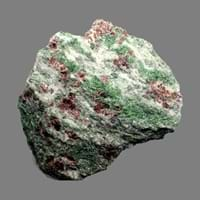Eclogite and Dacite
Definition
Definition
Eclogite is an extreme metamorphic rock, formed by regional metamorphism of basalt rock under very high pressure and temperature
Dacite is a volcanic igneous rock which is rintermediate in composition between andesite and rhyolite
History
Origin
Unknown
Romania and Moldova, Europe
Discoverer
René Just Haüy
Unknown
Etymology
From French, Greek eklogē selection with reference to the selective content of the rock + -ite1
From Dacia, a province of the Roman Empire which lay between the Danube River and Carpathian Mountains where the rock was first described
Class
Metamorphic Rocks
Igneous Rocks
Sub-Class
Durable Rock, Medium Hardness Rock
Durable Rock, Soft Rock
Family
Group
Not Applicable
Volcanic
Other Categories
Fine Grained Rock, Opaque Rock
Fine Grained Rock, Medium Grained Rock, Opaque Rock
Texture
Texture
Earthy
Aphanitic to Porphyritic
Color
Black, Brown, Colourless, Green, Grey, Pink, White
Bluish - Grey, Brown, Grey, Light to Dark Grey
Maintenance
Less
Less
Durability
Durable
Durable
Water Resistant
No
No
Scratch Resistant
Yes
No
Stain Resistant
Yes
No
Wind Resistant
Yes
No
Acid Resistant
No
No
Appearance
Dull, Banded and Foilated
Vesicular
Uses
Architecture
Interior Uses
Decorative Aggregates, Interior Decoration
Decorative Aggregates, Entryways, Interior Decoration
Exterior Uses
Paving Stone, Garden Decoration
As Building Stone, Paving Stone, Garden Decoration
Other Architectural Uses
Curbing
Curbing
Industry
Construction Industry
Not Yet Used
As Dimension Stone, Construction Aggregate, for Road Aggregate, Landscaping
Medical Industry
In Chemical and Pharmaceutical Industry, Medicines and Cosmetics
Not Yet Used
Antiquity Uses
Artifacts
Artifacts
Other Uses
Commercial Uses
Creating Artwork, Gemstone
Commemorative Tablets, Creating Artwork
Types
Types
Not Available
Footwall Dacite, Hanging wall Dacite, Tuff and Biotite Dacite
Features
Available in Lots of Colors and Patterns, Generally rough to touch, Is one of the oldest rock
Host Rock for Lead, Is one of the oldest rock
Archaeological Significance
Monuments
Not Yet Used
Not Yet Used
Famous Monuments
Not Applicable
Not Applicable
Sculpture
Not Yet Used
Not Yet Used
Famous Sculptures
Not Applicable
Not Applicable
Pictographs
Used
Used
Petroglyphs
Used
Used
Figurines
Not Yet Used
Not Yet Used
Fossils
Absent
Absent
Formation
Formation
Eclogite forms from high-pressure metamorphism of mafic igneous rocks mainly, basalt or gabbro as it plunges into the mantle in a subduction zone.
Dacitic magma is formed by the subduction of young oceanic crust under a thick felsic continental plate. Further, the Oceanic crust is hydrothermally altered as quartz and sodium are added.
Composition
Mineral Content
Amphibole, Coesite, Corundum, Dolomite, Garnet, Kyanite, Lawsonite, Paragonite, Phengite, Pyroxene, Quartz, Rutile, Zoisite
Amphibole, Apatite, Biotite, Feldspar, Garnet, Hornblade, Magnetite, Plagioclase, Pyroxene, Quartz, Zircon
Compound Content
Aluminium Oxide, NaCl, CaO, Carbon Dioxide, Iron(III) Oxide, Magnesium Carbonate, MgO, Sodium Oxide, Potassium, Sodium
Ca, Fe, Potassium Oxide, Mg, Potassium, Silicon Dioxide
Transformation
Metamorphism
No
Yes
Types of Metamorphism
Not Applicable
Burial Metamorphism, Cataclastic Metamorphism
Weathering
Yes
Yes
Types of Weathering
Mechanical Weathering
Biological Weathering, Chemical Weathering, Mechanical Weathering
Erosion
Yes
Yes
Types of Erosion
Chemical Erosion, Sea Erosion
Chemical Erosion
Properties
Physical Properties
Hardness
3.5-4
2-2.25
Grain Size
Fine Grained
Medium to Fine Coarse Grained
Fracture
Not Available
Conchoidal
Streak
White
White
Porosity
Less Porous
Less Porous
Luster
Subvitreous to Dull
Subvitreous to Dull
Cleavage
Perfect
Perfect
Toughness
Not Available
Not Available
Specific Gravity
2.86-2.87
2.86-2.87
Transparency
Opaque
Translucent
Density
3.2-3.6 g/cm3
2.77-2.771 g/cm3
Thermal Properties
Specific Heat Capacity
Not Available
0.92 kJ/Kg K
10
Resistance
Heat Resistant
Heat Resistant, Impact Resistant, Pressure Resistant, Wear Resistant
Reserves
Deposits in Eastern Continents
Asia
India, Kazakhstan, Kuwait, Russia, South Korea, Thailand, Turkey
Not Yet Found
Africa
Ethiopia, Morocco, South Africa
Not Yet Found
Europe
France, Germany, Italy, Norway, Scotland
France, Greece, Romania, Scotland, Spain
Others
Greenland
Not Yet Found
Deposits in Western Continents
North America
Canada, Costa Rica, Panama, USA
USA
South America
Argentina, Brazil, Colombia, Ecuador
Argentina, Bolivia, Chile, Colombia, Ecuador, Peru, Venezuela
Deposits in Oceania Continent
Australia
Central Australia, New Zealand, Queensland
New Zealand, South Australia, Western Australia
All about Eclogite and Dacite Properties
Know all about Eclogite and Dacite properties here. All properties of rocks are important as they define the type of rock and its application. Eclogite belongs to Metamorphic Rocks while Dacite belongs to Igneous Rocks.Texture of Eclogite is Earthy whereas that of Dacite is Aphanitic to Porphyritic. Eclogite appears Dull, Banded and Foilated and Dacite appears Vesicular. The luster of Eclogite and Dacite is subvitreous to dull. Eclogite is available in black, brown, colourless, green, grey, pink, white colors whereas Dacite is available in bluish - grey, brown, grey, light to dark grey colors. The commercial uses of Eclogite are creating artwork, gemstone and that of Dacite are commemorative tablets, creating artwork.
|
||
|
||
|










